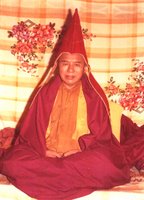 Samten Gyatso was Tulku Urgyen Rinpoche's main teacher and he was regarded as one of the emanations of the Indian master Vimalamitra. There is a fascinating story in Blazing Splendor about how a mind terma by the second Chokling of Tsikey was "confiscated" by Samten Gyatso. This unusual master also commissioned a lot of icon paintings which Tulku Urgyen Rinpoche brought with him to Nepal. And, since he was known to be a stickler for details and correctness, I have relied on them when the illustrations in Wellsprings were redrawn. Here you can see a slideshow of the line drawings included in Wellsprings, as well as a few others that didn't make it into the final version of the book. All the buddhas and masters were redrawn by Lhadripa Ngawang Zangpo.
Samten Gyatso was Tulku Urgyen Rinpoche's main teacher and he was regarded as one of the emanations of the Indian master Vimalamitra. There is a fascinating story in Blazing Splendor about how a mind terma by the second Chokling of Tsikey was "confiscated" by Samten Gyatso. This unusual master also commissioned a lot of icon paintings which Tulku Urgyen Rinpoche brought with him to Nepal. And, since he was known to be a stickler for details and correctness, I have relied on them when the illustrations in Wellsprings were redrawn. Here you can see a slideshow of the line drawings included in Wellsprings, as well as a few others that didn't make it into the final version of the book. All the buddhas and masters were redrawn by Lhadripa Ngawang Zangpo.
Wednesday, November 15, 2006
Drawings of the early masters in the Dzogchen lineage
 Samten Gyatso was Tulku Urgyen Rinpoche's main teacher and he was regarded as one of the emanations of the Indian master Vimalamitra. There is a fascinating story in Blazing Splendor about how a mind terma by the second Chokling of Tsikey was "confiscated" by Samten Gyatso. This unusual master also commissioned a lot of icon paintings which Tulku Urgyen Rinpoche brought with him to Nepal. And, since he was known to be a stickler for details and correctness, I have relied on them when the illustrations in Wellsprings were redrawn. Here you can see a slideshow of the line drawings included in Wellsprings, as well as a few others that didn't make it into the final version of the book. All the buddhas and masters were redrawn by Lhadripa Ngawang Zangpo.
Samten Gyatso was Tulku Urgyen Rinpoche's main teacher and he was regarded as one of the emanations of the Indian master Vimalamitra. There is a fascinating story in Blazing Splendor about how a mind terma by the second Chokling of Tsikey was "confiscated" by Samten Gyatso. This unusual master also commissioned a lot of icon paintings which Tulku Urgyen Rinpoche brought with him to Nepal. And, since he was known to be a stickler for details and correctness, I have relied on them when the illustrations in Wellsprings were redrawn. Here you can see a slideshow of the line drawings included in Wellsprings, as well as a few others that didn't make it into the final version of the book. All the buddhas and masters were redrawn by Lhadripa Ngawang Zangpo.
Tuesday, November 07, 2006
Vimalamitra
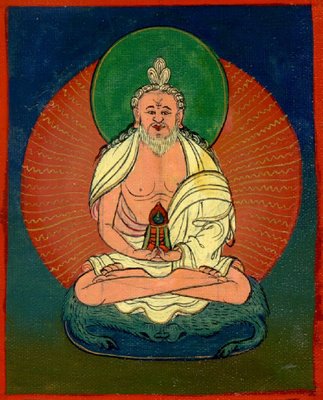
One of the most prominent historical figures in the Dzogchen lineage, and also in Blazing Splendor, is the amazing master Vimalamitra, a direct disciple of Shri Singha. When Padmasambhava arrived in Tibet, he perceived that the time was ready for Vimalamitra to teach the Great Perfection, and therefore bestowed his own lineage of Heart Essence upon only a few worthy disciples. The wisdom dakini Yeshe Tsogyal then concealed his teachings in the form of terma treasures for future generations. Padmasambhava’s profound hidden treasures containing his instructions on the Great Perfection are therefore primarily found among the revelations of the major tertön masters who have appeared over the centuries since the fifty-five years and six months Padmasambhava spent among the snowy ranges of Tibet.
Vimalamitra's lineage, however, was continued. I would like to introduce Wellsprings of the Great Perfection, (a new book from Rangjung Yeshe Publications), which contains many of his songs, excerpts from the Heart Essence of Vimalamitra and many other references. The first excerpt describes the mind transmission of the conquerors and the twelve Dzogchen buddhas, among whom Buddha Shakyamuni is the twelvth. Here is a record of his meeting with Shri Singha:
It was about then that the son of the king Dhahena Chadu and his wife Singha Shipitika, a monk known as Vimalamitra who was learned in the five topics of knowledge, yearned deeply to know the essential nature. He met Shri Singha and requested the meaning of the realized state, who then bestowed it in full and condensed the essential meaning for him in song:
Five poisons, unrejected, are the five great wisdoms,
While samsara, unrejected, is a timeless, perfect purity.
And once you realize your mind itself is buddha,
There is no state to realize apart from this awakened mind.
On hearing this, Vimalamitra understood the basic intent and then expressed his realization:
A spacious vast is dharmata, ungrasped by thought.
This space of mind itself defies imagination.
Within awakened mind which is no object to conceive,
The basic nature is not gained through cultivation.
Not wrought by meditation, timeless, empty, not apart,
The training is this sameness free of thinking.
The picture is a small painting commisioned by Samten Gyatso, who was Tulku Urgyen Rinpoche's primary teacher. It belong to an extraordinary collection of the early masters in the Dzogchen lineage now kept at the Ka-Nying Shedrub Ling monastery in Nepal.
Thursday, October 12, 2006
Tulku Urgyen Rinpoche at Bright Hill in Singapore

This picture was was taken at the Bright Hill Temple in Singapore, propably in 1990. The special costume Tulku Urgyen Rinpoche is wearing signifies his role as a tantric master while he performs a ritual for dispelling negative forces. You can see the old reverend Sifu sitting to the left. Rinpoche really liked him.
The photo is from Jennifer Wang. Thanks Jennifer!
Saturday, September 02, 2006
Tsechu Gompa
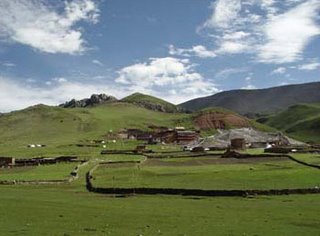
Here's a lovely picture of Tsechu Gompa from Adeu Rinpoche's website.
Adeu Rinpoche met Tulku Urgyen when he was quite young as he describes in this excerpt from an interview:
CTF: When did Rinpoche first meet Kyabje Tulku Urgyen Rinpoche?
Rinpoche: The first time I met Tulku Urgyen was when Samten Gyatso came and gave the extensive empowerments of Tukdrub Barchey Kunsel which lasted about an entire month. During this time Tulku Urgyen, we called him Tulku Karma Urgyen, acted as the shrine master and made all the tormas, he was also Samten Gyatso’s attendant together with another servent named Dudul. Another time we met was when Samten Gyatso was giving the Barom Kagyu empowerments and Tulku Urgyen alternated with another as umdze (chant master). On another occasion he came back with his father, Chimey Dorje, his brothers Pema Jigmé and Tenzin Dorje. They all came and it was during this time that I became good friends with Tulku Urgyen.
CTF: Could Rinpoche please tell us what Kyabje Tulku Urgyen was like at that time?
Rinpoche: I was really young, just a kid, and Tulku Urgyen was young too. He seemed to become quite fond of me and, you could say he would act as my babysitter. He was very skilled in different games, we would carve wood together and make drawings and masks. He was quite adept at these sorts of things, so he would distract me by playing with me. Sometimes he would run around with me on his shoulders. His brother, Tendzin Dorje, wasn’t interested in playing any games at all, he would just stay by himself and never do anything, so I never got close to him. But Tulku Urgyen was much more playful.
Wednesday, August 30, 2006
Tulku Urgyen in Singapore
Tuesday, July 18, 2006
Review of Blazing Splendor on Amazon
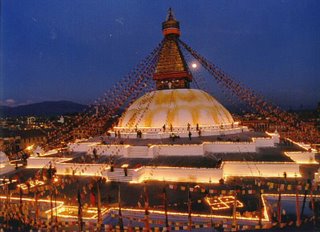
This volume is wonderfully fresh and accessible. It is like sitting, listening to stories told by a dear friend or relative. There are charming details, remarkable personal observations of many of the greatest lamas of the late 19th and early 20th centuries, down through Dzongsar Khyentse, Dilgo Khyentse and the 16th Karmapa. A deep theme throughout is that of the "terton", the gifted soul who uncovers "treasures" or "terma" hidden by Padmasambhava to be discovered when the time and times are correct. The author's great grandfather, Chokgyur Lingpa, was one of the last and greatest tertons, and the teachings thus uncovered - how and where they occurred, who was involved, the lineage of those who received these teachings, and so forth - is central to the story. I have found nothing like this in any of the many I've read on Tibet and the Tibetans.
Tulku Urgyen Rinpoche tells stories of these events that go back a considerable ways before he was born, into the 19th century, when Tibet was a world unto itself. He ends the book with a relatively brief description of the work he undertook at the direction of the 16th Karmapa to build a monastery near the great stupa of Boudanath, near Kathmandu, many years after his departure from Tibet in 1955. One sees glimpses throughout the narrative of the coming debacle; remarkable prophecies, side by side with engaging tales of his encounters with masters of the Dharma. It is a unique account, not to be missed, especially by those who seek a deeper understanding of how the great lamas of Tibet in that time lived their lives, related to each other, maintained their lineages and looked forward to preservation of the Dharma in a changed world. Altogether enchanting!
--David Nichols
The temple in Boudha
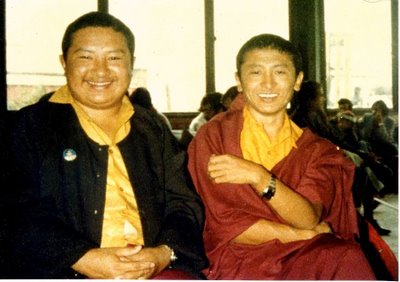 A little more background and some new pictures from the early '70s (the text is from Blazing Splendor by Tulku Urgyen Rinpoche):
A little more background and some new pictures from the early '70s (the text is from Blazing Splendor by Tulku Urgyen Rinpoche):At the Karmapa’s suggestion, I went to Malaysia with three attendants. Our little gang of four robed people were the first Tibetan lamas to visit. The trip lasted three months and I was able to accumulate a fair amount of funds from faithful Chinese Buddhists there.
I had decided to use the money to improve the temple at Nagi Gompa. However, once I got back to Nepal and started conferring with Ram Lal about how best to use the funds, a letter arrived from my two older sons, Chökyi Nyima and Chokling. They were finishing up their studies at Rumtek with the Karmapa and other great masters.
The letter said:
Dear Father and Mother,
The Karmapa has told us both that we must build a monastery. We are too young to do anything about it now, but we have heard that the Chini Lama offered you some land at the Great Stupa. Please build a small monastery there. It doesn’t have to be two stories; one is fine.
The Karmapa hadn’t singled out Chökyi Nyima and Chokling to build a monastery—he had told the same thing to every single tulku and lama at Rumtek that year. Anyway, this is how I embarked on building Ka-Nying Shedrub Ling, the monastery at the Boudha Stupa.
When the building was completed, I thought, “The Karmapa is my ultimate object of refuge; it would be wonderful if he could come and perform the consecration.” So on my next visit to Rumtek, I told the Karmapa, “I have finished building a small monastery in Boudha, and I have great hopes that you will pay it a visit. I am here to request you to go there and give the Treasury of Kagyu Tantric Teachings.”
 A little more background and some new pictures from the early '70s (the text is from Blazing Splendor by Tulku Urgyen Rinpoche):
A little more background and some new pictures from the early '70s (the text is from Blazing Splendor by Tulku Urgyen Rinpoche):The Karmapa replied, “That is very sweet of you; I will definitely come. You have my word. I need to go to India first, but after that I will come to Nepal.”
He came soon after. He also consecrated the temple and statues at Nagi Gompa. He gave the empowerments and then returned to Rumtek.
Friday, July 07, 2006
Repeating the Words of the Buddha - back in print

In Repeating the Words of the Buddha, Tulku Urgyen Rinpoche unfolds the path to enlightenment, which is simply the gradual uncovering of the awakened state already present in oneself.
With the benevolence and brilliance of a realized being, Rinpoche illustrates in a lucid, humorous fashion the essential points of spiritual practice, inseparable from everyday life.
Tulku Urgyen Rinpoche was among Tibetan Buddhism’s greatest masters of the 20th century, and pivotal in bringing the highest Buddhist teachings to the West.
New and revised edition.
Repeating the Words of the Buddha - webpage
Wednesday, July 05, 2006
Blessings
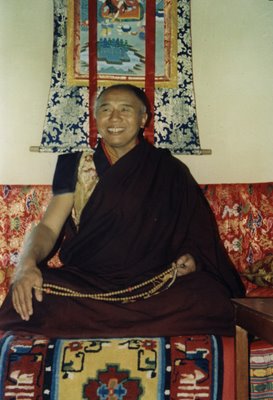
During a stay at Nagi Gompa in 1994 I had the opportunity to ask Tulku Urgyen the following:
MT: I was wondering if Rinpoche could explain exactly what ‘blessing’ is?
Rinpoche: What people usually consider blessings are what I would call ‘superficial blessings.’ It’s like when you have something you want to get rid of and you ask, “Please bless me to be free from what I don’t like,” whether this is being sick or in pain, evil spirits are attacking you, your business isn’t going that well, etc.. So, people ask for something to wear around their necks, something to eat, maybe some charm to be made and so on. Then when they feel better, the evil spirits are repelled, business is going well or whatever, they say, “I got the blessings.” These are known as ‘superficial blessings.’
On the other hand, the real blessings are the oral instructions on how to become enlightened in a single lifetime, which you can receive from a qualified master. That’s the real kind of blessing.
Monday, June 19, 2006
Tulku Urgyen Rinpoche on "one mind"
It is said that “there is no buddha apart from your own mind.” We do not have two minds. There is just one mind which is either deluded or undeluded. The buddha nature is exactly the originally unmistaken quality of our mind, also known as Samantabhadra, the dharmakaya buddha.
--from Repeating the Words of the Buddha
Monday, June 12, 2006
12 Trungpa Tulku receives the New Treasures

Trungpa Rinpoche received the Abhisheka for Terser, an important terma found by the great Terton Chojyur (Chokgyur) Lingpa, given by the current Chojyur Lingpa at Terton monastery near Surmang; this terma has special significance for Surmang, where a drubchen and lama dancing are practiced for it every year. This abhisheka lasted about one and one-half months, after which Trungpa Rinpoche returned to Surmang, where he has been concentrating on his ngondro practice.
From: www.konchok.org/trungpa.html
Saturday, June 10, 2006
Imprint in the Moon Cave
Thursday, June 01, 2006
Friday, May 12, 2006
Chokyi Nyima Rinpoche's Saturday Talks

Back in 1983 Tulku Urgyen Rinpoche's oldest son began a weekly semi-formal gathering centered around a lecture, with questions and answers at the end. Slowly these teachings have become known as the Saturday Talks and are mentioned in many of the travel guidebooks to Nepal. Many of them are being made available to the community of practitioners over the Internet at:
http://groups.yahoo.com/group/gomde/
Summer travel schedule: http://gomde.dk/index.asp?mode=Calendar&language=english
Thursday, May 11, 2006
The film of Milarepa

The father of Tulku Urgyen Rinpoche's reincarnation is not only the incarnation of Neten Chokling, an important lineage master mentioned repeatedly in Blazing Splendor, but also the director of the new and acclaimed film of Milarepa's early life. You can read the interview with him on http://www.milarepamovie.com/film/director.htm
Wednesday, May 10, 2006
Early photo of Dzongsar Khyentse, Jamyang Khyentse Chökyi Lodrö
 We are very fortunate to be able to share this old picture of one of the teachers of Tulku Urgyen Rinpoche. It comes from the Kela Chokling Tulku's new website: www.chokling.org (all in Chinese)
We are very fortunate to be able to share this old picture of one of the teachers of Tulku Urgyen Rinpoche. It comes from the Kela Chokling Tulku's new website: www.chokling.org (all in Chinese)Sogyal Rinpoche writes in his Introduction to Blazing Splendor:
I first met Tulku Urgyen Rinpoche when I was very young, because, as he explains in this book, he came many times to receive teachings from my master Dzongsar Khyentse, Jamyang Khyentse Chökyi Lodrö. When, years later, I requested Tulku Urgyen Rinpoche for teachings, he recalled how he had always seen me at the side of Jamyang Khyentse, and our mutual bond through our proximity to this great teacher gave us both a deep feeling of closeness.
Tulku Urgyen Rinpoche said about this master:
When Old Khyentse passed away, the fifteenth Karmapa saw in a vision that instead of just a single reincarnation, twenty-five emanations would appear, each embodying one of the twenty-five aspects of fruition: five each for enlightened body, speech, mind, qualities, and activity. Among these, five principal incarnations were recognized and enthroned. That’s why we see so many reincarnations these days with the name Khyentse.
It is said that the activity of these amazing Khyentse incarnations is unceasing, like the moon rising when the sun sets: when one passes away, another appears in his place. When he died, several tulkus appeared to take over his Dharma activities. Seen from our side, while one of them dissolves back into the buddhafield, another emanation appears, sometimes even more brilliant than the previous one. After the great Khyentse died, Dzongsar Khyentse appeared, who was equally amazing. Then when Dzongsar Khyentse set, Dilgo Khyentse rose.
Tuesday, May 02, 2006
Two excerpts about meditation by Tulku Urgyen Rinpoche
The traditional phrase is: cultivate shamatha; train in vipashyana. Buddhism never says that shamatha and vipashyana are superfluous and should be ignored or totally set aside. Nor would I ever teach that. But there are times when I seemingly put down shamatha a little bit. There is a reason for that, and that reason is found only in a particular context.
The context of the general teachings is one of talking to a sentient being who is experiencing uninterrupted bewilderment—one thought or emotion after another like the surface of the ocean in turmoil, without any recognition of mind-essence. This confusion is continuous, with almost no break, life after life. To tell such a person that shamatha is unnecessary is definitely not the correct way of teaching, because that person’s mind is like a drunken elephant or a crazy monkey; it simply won’t stay quiet. Such a mind has grown used to the habit of following after what is thought of, without any insight whatsoever. Shamatha is a skillful means to deal with this state. Once confused thoughts have subsided to some extent, it is easier to recognize the clear insight of emptiness. It is therefore never taught that shamatha and vipashyana are unnecessary.
Teaching styles are adapted to the two basic types of mentality: one oriented toward perceived objects, the other toward the knowing mind. The first mentality pursues sights, sounds, smells, tastes, textures, and mental objects and is unstable in buddha nature. This is the situation with the threefold bewilderment—the bewilderment of object, sense faculty, and sense perception, which causes rebirth in an ordinary body. Due to this deep-seated habit of getting caught up in one thought after another, we traverse through endless samsara. To stabilize such a mind, the first teachings need to show that person how to calm down, how to attain or resolve upon some steadfast quality within the turmoil. It’s like the example of muddy water: unless and until the water is clear, you can’t see the reflection of your face. Likewise, instructions on shamatha are essential for the individual who gets carried away by thoughts.
Thoughts come out of our empty cognizance. They don’t come only from the empty quality. Space doesn’t have any thoughts, nor do the four elements. Sights, sounds, and other sensations do not think. The five sense doors do not think. Thoughts are in the mind, and this mind, as I have mentioned so often, is the unity of being empty and cognizant. If it were only empty, there would be no way thoughts could arise. Thoughts come only from the empty cognizance.
The general vehicles hold that the method of shamatha is necessary in order to abide peacefully. To counteract our tendency to constantly fabricate, the buddhas taught us how to rely on a support. By getting accustomed to this support, our attention becomes stabilized, able to remain steady. At this point it is much easier to have pointed out that the attention’s nature is empty cognizance. But please remember that merely abiding, merely resting in the stability of shamatha practice, does not guarantee the recognition of the naked state of self-existing wakefulness.
Generally speaking, mind has many different characteristics—some good, some bad, some calm, some untamable. Some people grasp with desire, some are more aggressive; there are so many different kinds of worldly attitudes. If you want your mind to become quiet and still, it will become quiet and still, provided you train long enough. It will indeed—but that is not a liberated state.
The process of becoming quiet is like a person learning how to sit down instead of roaming about bewildered and confused. Still, looking at him from a distance while he sits doesn’t necessarily give any indication of his true character. And, as you know, people have different personalities. One person may be very gentle, disciplined, and kind—but while he is just sitting there, you won’t know that. Another one may be very crude, short-tempered, and violent, but you won’t know that either. These characteristics only show themselves once a person’s thoughts begin to move again. When thoughts move, we usually become caught up in delusion. At the same time, our nature is primordially free of the obscuration of emotions and thoughts. Thoughts and emotions are only temporary. The actual character of mind is one of self-existing wakefulness, the state realized by all buddhas.

From this Dzogchen perspective, shamatha is the unchanging quality of innate steadiness, while the natural sense of being awake is the vipashyana aspect. Neither of these is produced or fabricated in any way. Saying that shamatha is not needed refers to the stillness of mind-made fabrication. When I told you before to not meditate, it was to not meditate in the sense of mind-made meditation. It was that kind of shamatha I told you to stop.
Clear seeing, vipashyana, is your empty cognizance, your naked awareness beyond waxing and waning. This sentence has incredible meaning. In Dzogchen it refers to the true recognition of rigpa, while in Mahamudra it is called the innate suchness. This is when the real is recognized. It can be called many things, but in short it is the seeing of mind-essence simultaneously with looking. “Seen the moment you look. Free the moment it’s seen.” There is not a single thought that can stick to that state. However, after a bit of time you discover that you are again looking at something seen. That is when thought has arrived. Then you need to apply “remindfulness,” and once again, immediately, the looker is dropped. Relax into uncontrived naturalness!
When remaining without doing anything whatsoever, there is total letting go. In the same moment there is also a sense of being wide awake; there is an awake quality that is unproduced.
Simultaneous with the disappearance of thought, there is an awake quality that is like the radiant flame of a candle, which exists all by itself. That awake quality doesn’t need to be supported through meditation, because it is not something that is cultivated. Since its recognition lasts for only a short while, it is necessary to remind yourself again. But honestly, how far away is it to get to that moment? When you put your finger out in the air to touch space, how far do you need to move your hand forward before you connect with space? In the same way, the very moment you recognize mind-essence, it is seen the very moment you look. It is not that at some later point you will see it or that you have to continuously look, look, look for it. There are not two different things going on here.
The recognition of emptiness is accomplished the moment you look. “Seeing no thing is the supreme sight.” When seeing emptiness, you don’t need to do anything whatsoever to it. The key word here is uncontrived, which means you don’t have to alter it in any way; just leave it as it naturally is. At that moment, you are totally out of a job; there is nothing you need to do to it. In other words, no act of meditating is necessary at this point. That is what I meant by “Don’t meditate.” Because at that moment whatever you do to try to keep or prolong the natural state only envelops it in more activity and complexity, which is not really what we need. We have been doing that nonstop anyway, for countless lifetimes.
The perfect dharmakaya is when thought has been allowed to subside. Ordinary beings have fallen under the influence of thought. It is a matter of either recognizing or not. In Dzogchen, the essence is seen the moment you look. Yet, dharmata is not a thing to be seen. If it were, it would be a product of mind.
Sentient beings hold on to this moment. In the present moment, the past has ceased and the future has not arrived. Be free of the three times; then there is nothing except being empty. Trekchö is like cutting through a string; there is no thought conceptualizing past, future, or present. Free of the thoughts of the three times, your present, fresh wakefulness is rigpa.
The shamatha I told you to be free of, in the sense of not meditating, is mind-made peace. It is extremely good that you have dropped it. Mind-made peace is not the perfect path to liberation. Existence and peace, samsara and nirvana—we need to be free of both of these. That is the perfect state of enlightenment.
The natural state of totally naked awareness has the quality of being unimpeded; that is true freedom. Recognize the moment of totally open and unimpeded awareness, which does not hold or dwell on anything whatsoever. This is not the mere absence of thought activity, as in induced serenity. That is one major difference. That is also the main reason that shamatha is not by itself the true path of liberation; it needs to be conjoined with the clear seeing of vipashyana on every level, all the way to complete enlightenment.
The ultimate achievement through shamatha practice, with partial but not the full and clear seeing of vipashyana, which is the recognition of mind-essence, is to attain the nirvana of an arhat, but not the nondwelling true and complete enlightenment of a buddha. We should always aspire toward the complete enlightenment that dwells neither in samsara nor in nirvana.
It is also possible to have a sustained meditative state of serenity and yet not be liberated. Here is a story about that. Once I was with my father at a benefactor’s house. The man who brought in the tea was a meditator. While carrying the tea in through the door, he somehow suddenly froze, the teakettle lifted in midair. One of the boys wanted to call him, but my father said, “No, let him be—if he drops the pot of boiling tea, it will make a mess; simply leave him be.” He stood there for hours, and as the sun was about to set, my father gently called his name into his ear. He slowly regained his senses. Someone said, “What happened?” He replied, “What do you mean what happened? I am bringing the tea.” They told him, “That was this morning. Now it is afternoon.” He said, “No, no, it is right now, I just came in with it.” He was interviewed more about what he experienced, and he said, “I didn’t experience anything at all—it was totally vacant, with nothing to express or explain, just totally quiet.” When he was told that so many hours had gone by, he was quite surprised, because to him it didn’t feel as if any time had passed.
Tuesday, April 25, 2006
New head of Lachab Monastery
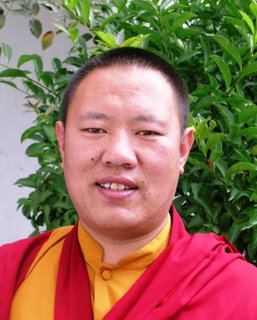
Just before leaving for Singapore, Chokyi Nyima Rinpoche handed me a letter to translate. It had been written by Ngaktrin Tulku last year, prior to his passing. The letter appoints Karma Gyaltsen Rinpoche to be incharge of the monasteries and retreat centers.
An announcement to all sublime upholders of the Dharma and faithful male and female practitioners and laypeople, especially the main lamas of area:
Karma Gyaltsen Rinpoche—who stems from a line of siddhas, the Tsangsar clan of Nangchen, and who is educated, disciplined and noble-minded, and is experienced and realized—has the qualifications for being responsible for the teachings and the monasteries. Accordingly, I have enthroned him has my successor in the position of crown ornament of Buddhadharma for Tsangsar Lachab Gompa, both the main and the branch monasteries.
It is therefore my hope and request that all sublime masters and faithful benefactors extend him their continued trust and assistance with joy and perseverance. Together with my fervent prayers to the Three Jewels who are the source of benefit and happiness for all beings and for the Buddha's teachings, this was written by Ngaktrin Tulku on the fifteenth day of the tenth month in year of the Female Wood Bird (2005).
Thursday, April 20, 2006
Shri Singha
 Sorry not much of interest has been happening here for the past couple of weeks but Erik has been up in retreat at Nagi Gompa. Here's a rather gorgeous picture of Shri Singha, to help tie you over until Erik returns and starts to share his photo collection with everyone once again.
Sorry not much of interest has been happening here for the past couple of weeks but Erik has been up in retreat at Nagi Gompa. Here's a rather gorgeous picture of Shri Singha, to help tie you over until Erik returns and starts to share his photo collection with everyone once again.Shri Singha was the chief disciple and successor of Manjushrimitra in the lineage of the Dzogchen teachings. He was born in the Chinese city of
Saturday, April 08, 2006
Review from Shambhala Sun
Thursday, March 16, 2006
Recent review of Blazing Splendor
In recent years, at least a small portion of the most important works in the vast Tibetan Buddhist literature has been translated and made available in English. The rate of publication is increasing as more people become able to translate Tibetan. Against this background, "Blazing Splendor" stands out - it is unique, a book that may mark a watershed in the understanding of Tibetan Buddhism by westerners.
"Blazing Splendor" is the memoirs of one of the greatest Tibetan Yogis of recent years - Tulku Urgyen Rinpoche. A collection of stories gathered over many years by his translators, its personal approach makes it different from either history or the formal biographies of great Lamas and masters of the past. Its intimate tone brings the reader right into the lives of Buddhist practitioners.
The book begins with Tulku Urgyen's grandmother, through whom Rinpoche heard many of the stories recorded in the book. It then dips back in time to the very beginnings of Buddhism in Tibet, providing important background information for those not already familiar with this history. It then moves forward again, giving a rich look into the lives of a an entire family of great Lamas and practitioners. The reader sees how a wide range of people, men and women, some highly revered, others nearly unnoticed, great Lamas and lay people, all led lives completely infused with Buddhist teachings.
While not structured as a Dharma text, the reader will find teachings embedded in the stories and these alone are worth the price of the book. Cumulatively, the effect of so many detailed stories and personal memories is to give the reader a rich awareness of life in a culture that was centered on the Dharma. Nothing else I've read over the years has had such a profound effect on me.
Reviewer: Susan Law (Hudson Valley, NY)
Wednesday, March 15, 2006
Sunday, March 12, 2006
Announcement of Tulku Urgyen Rinpoche's Reincarnation

This is a record of the speech given at Ka-Nying Shedrub Ling by Chokyi Nyima Rinpoche on the third day of the Tibetan New Year, 2006. Present at the auspicious occasion were at a large number of members of Tulku Urgyen Rinpoche’s family headed by the Chokling of Tsikey, Drubwang Tsoknyi, Phakchok of Riwoche, Mayum Dechen Paldron, Lama Tashi Dorje, Mayum Sonam Chodron, Sangyum Chime Yangdzom and many others. The main assembly hall was filled with lamas, monks and nuns, and members of the sangha from all over the world. After chanting the verses of invocation, Chökyi Nyima Rinpoche began speaking:
Today I have good news for you. My late father was a guru to all of us, in all our various monasteries and sanghas, and I know we all trusted him deeply with pure perception. He was the kind master from whom we received not only empowerments and reading transmissions but also the important pith instructions. ...
The whole speech is on:
http://www.rangjung.com/gl/Losar_Announcement_2006.htm
Friday, March 10, 2006
Wedding picture of Neten Chokling and Sangyum Choyang
Ceremonies held at the Ka-Nying Shedrub Ling Monastery in Nepal
Should you wish to make a donation to these activities, the Monlam website has now been updated to include these special events:
http://www.monlam.org/mainprayers.html
With best wishes, Everyone at Monlam.org
February 22 Tulku Urgyen Rinpoche’s Anniversary
February 23-27 Vajrakilaya puja
February 28 Tibetan New Year – Year of the Fire Dog
March 7-16 White Amitayus Drubchen
March 14 Festival of Miracles (Chotrul Duchen)
March 24 Lotus Dakini Puja (Kurukule)
March 28 Dharma Protector Puja
March 29 Ngakso Puja (Ocean of Amrita)
April 6-14 Ngakso Puja
April 23 Lotus Dakini Puja (Kurukule)
April 26 Dharma Protector Puja
April 27 Ngakso Puja (Ocean of Amrita)
Wednesday, March 08, 2006
Ngaktrin Tulku passes on

The fifth Ngaktrin Tulku -- Tsewang Dechen, born 1941, has just passed on. He was the chief abbot of Lachab Gompa and its branch nunnery and retreat centers.
He was also a close student of Tulku Urgyen Rinpoche and received the transmissions of the New Treasures from him.
Long-Yang, his attendant relates: As soon as Ngaktrin Rinpoche heard news of Tulku Urgyen's reincarnation, he said, "I have waited for this. If the sons have no doubt then I'm satisfied." He died the next day.
His body will be taken to Fortress Peak for one week and then on to Lachab Gompa.
More info on the Ngaktrin tulku line on:
http://www.rangjung.com/authors/Ngaktrin_Tulku_Incarnations.htm
Thursday, March 02, 2006
Rebirth of Tulku Urgyen Rinpoche
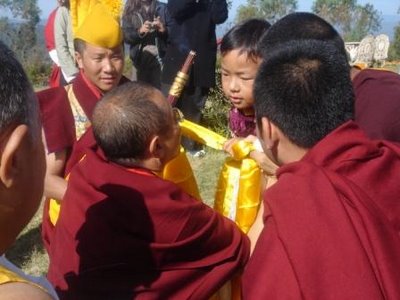
The long awaited announcement has finally come.
Tulku Urgyen Rinpoche has taken rebirth in the family of Neten Chokling Rinpoche and his beautiful wife, Tendzin Choyang Gyari.
Urgyen Jigmey Rabsel was born in the year of the snake & is 4 1/2 years old (6 Tibetan). He was born in the USA & has an American passport.
Kyabje Trulshik Rinpoche undeniably recognized him as the reincarnation of Tulku Urgyen Rinpoche after carefully investigating his experience while in strict retreat in the holy pilgrimage place in Maritika, Nepal.
The child is currently in Bir India with his parents & will be given a new name at the time of the hair cutting ceremony.
As an auspicious coincidence, Tulkus Chokyi Nyima, Tsikey Chokling, Tsoknyi & Phakchok Rinpoches as well as Tenpa Chophel will travel to Bir on March 3rd to meet the child and his parents. There will be a ceremony at the Neten Chokling Gonpa in Bir and with the sons of the former Neten Chokling Rinpoche, Urgyen Topgyal, Khyentse Yeshe, Jamyang & Dzigar Kongtrul Rinpoches.
This is a very happy time for all of the students of Tulku Urgyen Rinpoche. Please join together to pray for the further unfolding of auspicious circumstances in regards to this joyous event.
More information about the yangsi can be found on Tulku Urgyen's son Tsoknyi Rinpoche's website:
http://www.pundarika.org/tulku_urgyen_yangsi.htm
Wednesday, March 01, 2006
Sunday, February 19, 2006
Lord of Siddhas
This is the great master Shakya Shri, who was the root guru of Tulku Urgyen's Uncle Tersey. A full chapter is dedicated to this incredible yogi in Blazing Splendor. Here are the opening lines to give you a taste:
During his stay in Central Tibet, Uncle Tersey frequented the encampment of his root guru Shakya Shri, the great siddha-master. Shakya Shri was also known as the Lord of Siddhas and as Precious Realised Master. His main guru was Old Khyentse.
"Shakya Shri lived with about seven hundred disciples in Kyipuk," Uncle Tersey told me. "His disciples had dug caves all around the two surrounding slopes, while others stayed in tiny tents made of either canvas or yak felt. Shakya Shri himself lived on a meadow in the only house around, which was a simple structure of stamped mud with one large window."
A fine translation of Shakya Shri's biography together with some of his teachings and poems has been made by Elio Guarisco and we look forward to its eventual publication.
Thursday, February 09, 2006
A Path Strewn with Flowers and Bones
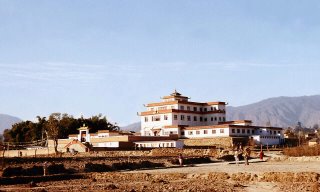
The first day, Rinpoche spent several hours devilishly challenging the trekker, hippy and expatriate attendees to prove whether or not the table in front of him really existed. I was enthralled by his wakeful, playful manner and humor, and his impeccable logic. It was deconstruction on the fly, before I had ever heard that term or it became in vogue. I went back every day I could, and again on Saturdays.
** ** **
While I grew more and more keenly interested in Buddhist philosophy, and was touched by the devout spirit of the many Tibetans around me, I held firm to the notion that I was a free agent, an independent operator. I didn't want to join any guild or identify with any group. I scoffed when Chad Leech asked me whether I planned to take refuge. Why become a Buddhist? What were the perks and benefits? I could meditate without a membership card.
At the conclusion of Chokyi Nyima's seminar, the student group was to travel up to Nagi Gompa, a small speck visible far up the northernmost slope of the Kathmandu Valley, for a special instruction from Tulku Urgyen himself, whom CN referred to variously as "the boss" and "head office." CN also offered the opportunity and arranged for me to stay on for a while at Nagi after the teaching, for a private meditation retreat.
It was a rough hike indeed up to Nagi in those days, the last part a traverse up steep dirt trails. I watched Chokling Rinpoche, CN's younger brother, and a little portly, huff and puff his way up, with some generous support from below on his backside. The gompa (monastery) itself was just a small chapel in the middle of a clearing, without much light. After we had been sitting a while, Tulku Urgyen entered the shrine hall in response to the soulful, lilting chants of the resident nuns. He taught us to understand and perceive the nature of our minds, basing his remarks on the famous verse from the Buddhist canon:
Thus taught the Buddha:
Abstain from all harmful actions,
Practice magnificent virtue, and
Thoroughly train your own mind.
After the teaching, an endless stream of local pilgrims appeared from over the lip of the clearing to line up for a blessing from Tulku Urgyen, dressed in their finest holiday dresses and slacks. Before anyone in
Eventually, locals and foreigners alike began the trek home, back down into the valley, and I rolled my sleeping bag out onto the low bench in the back of the shrine hall on which the junior-most nuns sat during communal prayers, lit a candle, sat down, and began to practice as I had learned in my Insight meditation retreats.
After some days of "walking, walking," "breathing, breathing," and "thinking, thinking," and many hours gazing out from my perch on the flat ledge of a big cement ring girding the lone tree on the edge of the clearing, watching clouds unfurl over the valley, watching the simple herder cluck and chase after the few milk buffalo that served the gompa, the green shafts of barley wave in the breeze, I received, courtesy of a peculiar old Dutch woman who manifested in the shrine hall one day, a summons: "Tulku Urgyen says he will see you now."
"Please thank Tulku Urgyen for the offer, but I see no need to bother him. I have nothing to ask him, and am content to continue with my practice and retreat." Surprised by my answer, she beat a hasty retreat. The next day she appeared again, this time with more resolve. "You are to come see Tulku Urgyen now, you don't know what an unusual privilege it is to receive such an invitation." I demurred again, just barely.
The next day was the last of my scheduled stay. This time, there was no avoiding the call. Besides, what harm could there be in thanking Tulku Urgyen in person for allowing me to squat for ten days in the shrine, and take meals from his pair of young nun-chefs in a tiny back room, where they sniffed and wiped away tears as smoke billowed from the clay hearth stuffed with burning odds and ends of wood and yak dung?
I walked up the rickety, narrow staircase. The door opened before me. There across the room sat Tulku Urgyen in his meditation box next to a large picture window, waist wrapped in a simple blanket, more composed than I had ever thought it possible for anyone to be. He looked at me through his large glasses. I entered. I hardly noticed his student and translator, Erik Schmidt, sitting quietly by his side. "Do you have something to ask me?" Our eyes met, then I watched myself bow helplessly with uncontrived respect, struck to my very marrow by his presence, his calm, his mind enveloping the entire space and dissolving every last concept of self-importance I had carried into the room but a moment before.
With tears welling in my eyes and a slight tremor in my voice, I responded, "Yes, I wish to ask you to grant me the vows of refuge." We went through the ceremony together; Erik had to ask thrice whether the name was correct, verb and all -- Protected by the Three Jewels. Tulku Urgyen gave me ten rupees with a command to spend it all on my walk down the mountain, before I reached Boudhanath.
It was November 1981. My life had just completely changed. That old man in a blanket was the most genuine person I had ever met, by several orders of magnitude. I knew this the way I knew, one day earlier that spring as we returned from a Baha'i prayer meeting we had attended for our anthropology class, that I had fallen in love with Andrea Kozol -- only more so. Traipsing down the slopes with that ten rupee note burning a hole in my pocket, I was light as air, immensely glad to have made such a connection with Tulku Urgyen. I wanted to know what it was like to be him, wanted to be inside his mind, to learn everything he could possibly teach me. I cried thinking about what had just transpired, and vowed to follow every last word of advice he offered me.
(Excerpted from "A Path Strewn with Flowers and Bones," forthcoming. © 2006 Blazing Wisdom Institute, Inc. All rights reserved.)
Sunday, February 05, 2006
The Great Dakini of Tsurphu
Sunday, January 29, 2006
Tsechu Monastery and the Great Adeu Rinpoche

This is a picture of Tsechu Gompa in Nangchen. The abbot of Tsechu is a marvelous lama by the name of Adeu Rinpoche. Not only is Adeu Rinpoche one of the main holders of the Drukpa Kagyu lineage, but Tulku Urgyen used to "babysit" him when his teacher went to visit Tulku Urgyen's uncle Samten Gyatso. He talks about those early days in this interview.
You can learn more about Adeu Rinpoche at his website, where there are also lots more great photos.
Tuesday, January 17, 2006
Youth of Inconceivable Sublime Light
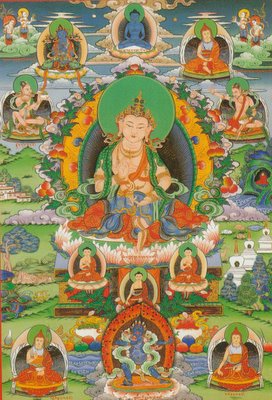
The main teaching of the original teacher Buddha Samantabhadra is Dzogchen, the Great Perfection. The teachings of Dzogchen are the pinnacle of all nine vehicles. Before the Dzogchen teachings arrived in our human world, they were propagated through the Gyalwa Gong-gyü, the mind transmission of the victorious ones, in the three divine realms: first in Akanishtha, then in Tushita, and lastly in the Realm of the 33 Gods, the world of Indra and his 32 vassal kings located on the summit of Mount Sumeru.
Generally, it is said that the 6,400,000 Dzogchen teachings entered this world via Garab Dorje, the first human vidyadhara, who directly received the transmission from the Buddha in the form of Vajrasattva. These teachings first arrived in Uddiyana, and later were propagated in India and Tibet. Before the era of Buddha Shakyamuni the Dzogchen teachings were propagated in our part of the universe by other buddhas known as the Twelve Dzogchen Teachers. Buddha Shakyamuni is usually counted as the fourth guide in this Excellent Aeon in which one thousand fully enlightened buddhas are to appear in our world. Although in this context he is known as the fourth guide, Shakyamuni is the twelfth in the line of Dzogchen teachers.
No Dzogchen teachings have occurred apart from the appearance of a buddha in this world, so we must count Buddha Shakyamuni as one of the chief teachers through whom the teachings were transmitted. He did, indeed, convey Dzogchen teachings, though not in the conventional manner. His conventional teachings were primarily received by those who had a karmic connection with the teachings appropriate to shravakas, pratyekabuddhas and bodhisattvas. It was not that they were not allowed to receive the Dzogchen teachings; their karmic fortune was such that they received the teachings to which they were suited. The Buddha gave Dzogchen teachings, as well as other Vajrayana instructions, by first manifesting the mandala of a deity and then imparting the tantric teachings to a retinue seated within that setting. This, however, does not lie within the scope of what was perceived by ordinary people.
--Tulku Urgyen Rinpoche
The Tangkha is depicting Youth of Inconceivable Sublime Light (khye’u snang dam pa bsam gyis mi khyab pa) one of the first of these Twelve Dzogchen Buddhas. Shakyamuni is the Twelfth. The painting was supervised by Nyoshul Khen Rinpoche shortly before his passing.
Monday, January 16, 2006
Longchenpa's likeness

My guru, Samten Gyatso, also had a deep fondness for the masters Longchenpa and Jigmey Lingpa. He would often read aloud from Longchenpa’s Seven Treasuries, not as a formal reading transmission but just for himself—slowly and in a gentle tone of voice. He always carried one of these seven volumes with him wherever he went, so that by the end of the year he would complete his reading of all seven. After some years, he knew exactly where to find every single detail mentioned anywhere in these Treasuries. He would sometimes comment, “How wonderful! What an amazing master Longchenpa must have been! How profound his words are!” -- from Blazing Splendor.
The picture is of an old statue made at the time of Longchenpa himself. The recent Dzogchen master Nyoshul Khen Rinpoche treasured this image highly and had it reproduced innumerable times. One of his main attendants and students, Khenpo Sonam Tobgyal Rinpoche, who now heads Riwoche Temple in Canada, made many of these with his own hands.
Saturday, January 14, 2006
On the roof of Ka-Nying Gompa in 1976
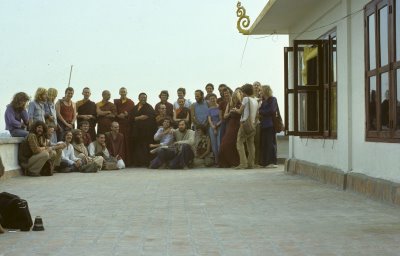
The place is Ka-Nying Shedrub Ling monastery. The occasion is the Sixteenth Karmapa who has come to Boudha to inaugurate Tulku Urgyen Rinpoche's and Chokyi Nyima Rinpoche's new gompa and confer the Treasury of Kagyu Teachings. Here is Khenchen Thrangu Rinpoche flanked by a sundry assembly of ordained monks and bearded ngakpas, 30 in all. Let's hear some names !
Matthew Kapstein & Edward Henning (who sent this picture) sit right below the british monk Lodro Thaye. Please let us know if you recognize anyone else.
Saturday, January 07, 2006
The great siddha Shakya Shri's sons repair the Boudha Stupa
 In the Early part of the 20th century the great siddha Shakya Shri sent his sons to restore the great stupa of Boudhanath. Here is a rare photo taken at the occasion. Another restoration, which took place half a century later, is captured on this page: http://blazing-splendor.blogspot.com/2005/11/tashi-who-becomes-shechen-rabjam.html
In the Early part of the 20th century the great siddha Shakya Shri sent his sons to restore the great stupa of Boudhanath. Here is a rare photo taken at the occasion. Another restoration, which took place half a century later, is captured on this page: http://blazing-splendor.blogspot.com/2005/11/tashi-who-becomes-shechen-rabjam.html
Tuesday, January 03, 2006
"Blazing Splendor" Reading at Karma Triyana DharmachakraWoodstock, NY, Feb 4, 2006 at 2 pm
In particular, as principal holder of the Chogling Treasure lineage, which was extremely famous and widespread in Eastern Tibet before the Communist invasion, Tulku Urgyen was close to the 15th Karmapa, Kakhyab Dorje, and was a personal guru and advisor to the 16th Karmapa, Rangjung Rigpa'i Dorje, for many years at Tsurphu Monastery and in exile, accompanying him on his first visit to KTD more than twenty-five years ago.
As we approach the 10th anniversary of the miraculous passing of Tulku Urgyen Rinpoche, the authors of Blazing Splendor have requested a small number of his close students to host commemorative readings of excerpts from Blazing Splendor to celebrate his life and his activities on behalf of our precious practice lineage.
KTD will host a reading by Lama Sherab Dorje on February 4, 2006 at 2 pm. Lama Sherab will read passages from the book that are of special import to the monastery and its lineage, as well as share personal stories and anecdotes about Tulku Urgyen and other great masters, and tell of his recent pilgrimmage to the vulture fortress retreat center atop Tsurphu monastery in Tibet.
Lama Sherab's special guest will be Heinz Insu Fenkl, Director of the Creative Writing Program at SUNY New Paltz, who will read excerpts from his forthcoming novel about the Buddha's life based on the sutras, entitled "Siddhartha Gautama." Heinz was a Pen/Hemingway awards finalist in 1996 for his novel, Memories of my Ghost Brother, soon to be reissued by Bo Leaf Press.
All are welcome and there is no charge for this event. Nonetheless, advance registration is strongly recommended. Please use the following contact information, and be sure to indicate that you are coming for the reading event.
You may also want to drop us an email to let us know that you will be there. Bardor Rinpoche is also teaching at KTD that weekend, and you may register for and attend that program as well. Ask KTD for further information.
Contact:
Thomas C. Schmidt /External Affairs Officer / Karma Triyana Dharmachakra
335 Meads Mountain Road
Woodstock, NY 12498 USA
PH: 845.679.5906 ext. 15 Fax: 845.679.4625 external.affairs@kagyu.org
http://www.kagyu.org
http://www.karmapa.net
